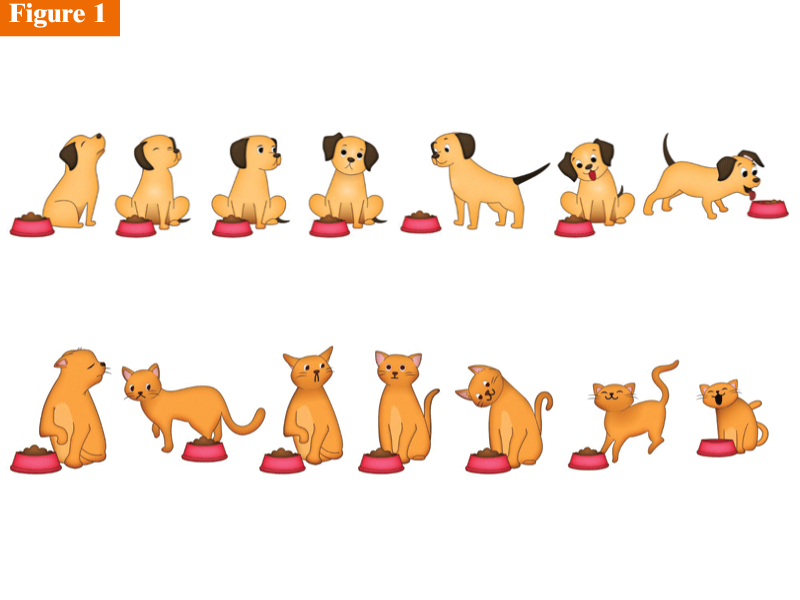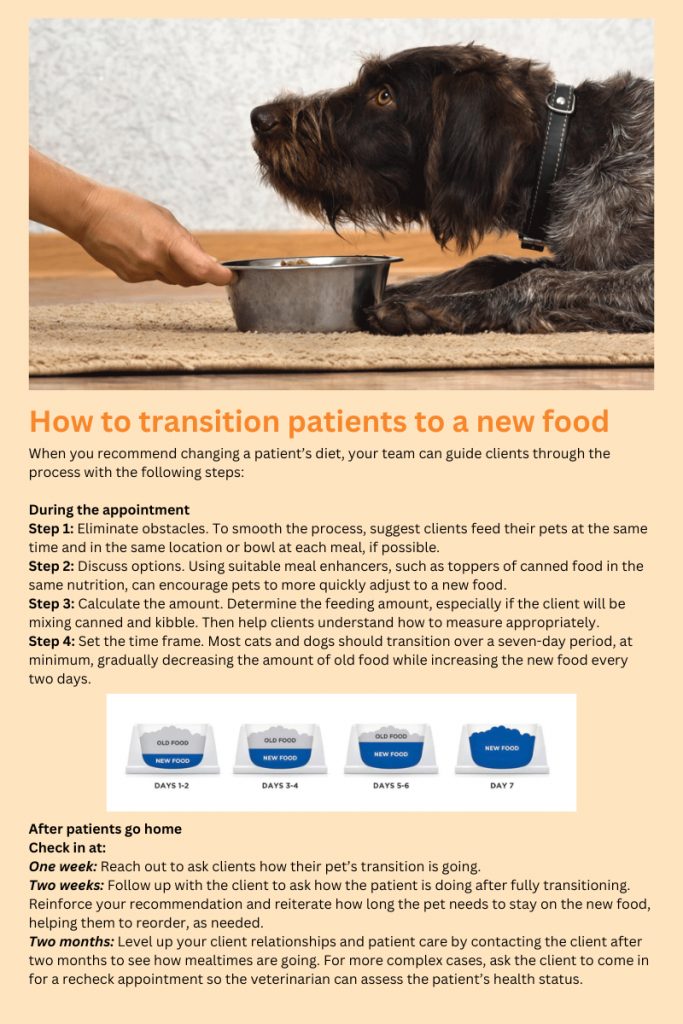
You have probably heard the saying, “Food is love.” Pet parents are embracing this notion as they increasingly consider their pets to be members of the family. More and more clients believe their pets need food that provides both optimal nutrition and a genuinely enjoyable taste. In fact, studies have highlighted pet parents placing more significance on the relationships with their companion animals tend to prioritize taste when selecting foods.1
Feed your client relationships by discussing science-based nutrition proven to appeal to pets’ and pet parents’ preferences. You will position your patients for better health, your clients for more enjoyable mealtimes, and your team for more positive client interactions.
Follow the science
When pets readily eat the food you recommend, client compliance increases and, more importantly, patients get the nutrition they need. Alternatively, when pets do not accept a recommended food, their health may suffer.
In these cases, clients might feel stressed and confused, question your recommendation, and look elsewhere for a different solution. This is especially concerning for patients with an acute illness or ongoing health challenge as clients often assess their pet’s quality of life based on whether their pets are eating enthusiastically or not eating at all.
Consider dogs with cancer. As a result of their condition or its treatments, dogs may experience inappetence, which leads to weight loss and contributes to cachexia. A recent study investigated the effectiveness of a therapeutic food in dogs with cancer.2 To assess the dogs’ eating enthusiasm for the food, pet parents used an emoji scale based on scientifically validated criteria (Figure 1).3

Of dogs enrolled in this feeding trial, 97 percent successfully transitioned over seven days to eating the study food. The mean eating enthusiasm score on the emoji scale (1=the least enthusiasm to eat; 7=the most enthusiasm to eat) for all dogs at the time of enrollment was high at 6.1 and continued to stay high during the study. Dogs with malignant tumors showed a significant improvement in eating enthusiasm by day three (P=0.0002) compared with baseline.
Palatability-focused research supports the development of wellness and therapeutic formulas well accepted by pets. Additionally, the study supports the creation of a variety of tasty forms and flavors allowing veterinarians to give clients options for feeding their pets. This way you can be confident the nutrition you recommend will help contribute to patients’ health and clients’ happiness.
Feed clients’ knowledge
Veterinary teams are highly encouraged to make nutrition a priority, i.e. a vital assessment included in every client-patient interaction. During routine appointments, quick nutrition conversations can make a big impact on patient health. For patients with more complex nutritional needs, proactively talking about how therapeutic nutrition is designed to taste great can ease clients’ worries.
One way to start the nutrition conversation is to set the stage, then ask a permission-granting question: “Nutrition is a key factor in your pet’s long-term health and quality of life. I’d like to have a conversation about the role of nutrition in [insert pet’s name]’s health today. Would that be okay with you?”
Then you can discuss how quality nutrition and enjoyable mealtimes contribute to healthier pets. Drive this point home with a human analogy: When physicians recommend reforming their patients’ diets, they usually recommend replacing foods, such as bacon, cheese, and doughnuts with more nutritious options, such as grilled chicken, broccoli, and brown rice. For people, making these healthier foods taste great can take a lot of effort. With pets, when you recommend pet food backed by taste technology research, this work has already been done, making it much easier for pet parents to comply with your recommendation.
With that in mind, turn the discussion to the specific food you recommend, explaining it is proven to provide nutritional benefits and appeal to pets’ preferences. Note the advantages of both in terms of health, ease of feeding, and so on.
In typical practice settings, it is ideal delegating the nutrition conversation to another member of the team, particularly a veterinary technician. Doing so saves time, leverages team members’ skills, and gives clients time to think about the veterinarian’s diet recommendation before talking about it in more detail.
Before ending your part of the discussion, let clients know a team member will help them choose the form or flavor of food best for their pet. Be sure to also list the options in your discharge notes to reinforce they can follow your recommendation while also choosing from a variety of forms, flavors, or textures to select the one their pet will enjoy most.
Serve up a team approach
Ideally, a practice will appoint an in-house nutrition “go-to” person. Again, this is often a veterinary technician who can take the lead on following through to meet the client’s needs once you make the nutritional recommendation.
To determine which form and flavor options best suit the client’s and pet’s lifestyle and preferences, the veterinary technician can ask these questions:
- Are there certain foods or treats you especially enjoy feeding your pet?
- Do you typically feed kibble or canned foods?
For therapeutic diets or in feeding situations that need troubleshooting, ask for more details with these types
of questions:
- What’s your routine for mealtime?
- How does mealtime go for you and for the pet?
- Is there anything you find particularly frustrating or that you wish would change?
Listening to any questions or comments the client may have presents the opportunity to further discuss the importance of quality, great-tasting nutrition for any pet. Once all the information is gathered, the technician and client can work together to make the final food selection.
In addition to veterinary technicians, the entire practice team can help support clients in the successful selection and feeding of the right pet food. For example, client service team members may get questions about food when clients check out. Ensure the whole team understands why your practice believes in the foods you recommend and can reinforce the message about the importance of feeding proven great-tasting, nutritious food.
This commentary helps end client appointments positively, even when pets need therapeutic nutrition. Allow clients to maintain the positive momentum at home by suggesting they continue providing treats, if that is something they desire. Do this either by reserving a portion of the pet’s daily feeding ration to give out as treats at special times during the day, or offer to send home compatible treats, if they’re available, to go along with the diet you recommended.
While the hope is that your initial recommendation works for each patient, pets are individuals and each one eats differently. If pets are not reacting as positively as expected, getting clients invested in enjoyable mealtimes can be an impetus for further discussion. Their feedback on their pet’s reactions and behaviors can help you adjust their expectations or adjust the recommended form or flavor to one that’s more readily consumed. Sometimes, a slower food transition is all it takes to get a pet to happily accept the new food.
Clients can give even more love by feeding pets nutrition that makes them as happy as they are healthy. This helps create stronger bonds between pets and people—and between clients and your practice.
Karen Shenoy, DVM, is chief veterinary officer for Hill’s Pet Nutrition U.S., where she has worked since 2008 in a number of professional, cross-functional and leadership roles of increasing responsibility.
Melissa Vanchina, MS, is director of product design for Hill’s, where she leads a team of 11 experts consisting of food and sensory scientists, engineers and chemists.
References
- Boya UO, Dotson MJ,Hyatt EM. A Comparison of Dog Food Choice Criteria across Dog Owner Segments: An Exploratory Study. Int J of Consum Stud. 2015;39(1):74-82.
- Anthony RM, Amundson MD, Brejda J, Becvarova I. Acceptance of a novel, highly palatable, calorically dense, and nutritionally complete diet in dogs with benign and malignant tumors. Vet Sci 2023;10(2):148 (https://doi.org/10.3390/vetsci10020148).
- Vanchina MA, Vondran JC, Swaney-Stueve M. Development and validation of an emoji-based pet eating enthusiasm scale, 2022 (Hill’s data on file).

